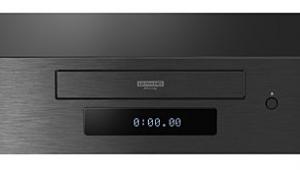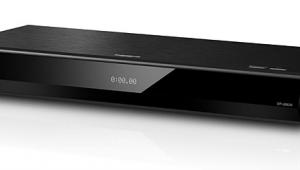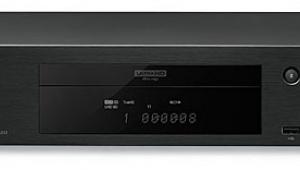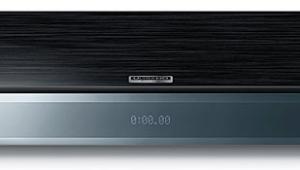Toshiba HD-A1 HD DVD Player Page 2
On several occasions the player stopped and displayed an HDMI error message in its front panel window when the HDMI connection broke lock with the display, either when I disconnected the cable or when the player was connected to a video switcher and I changed to another HDMI source and back again (those who use an HDMI switcher take note.) In this case, the only way I could clear the problem was to eject the disc and then restart it from the beginning.
 In addition, the player had trouble establishing an HDMI link to the SIM2 C3X projector. It would flash random colors on the screen, sometimes a bit of noise, and often a version of the source with whacked-out color for an instant before it locked—though on a few occasions I had to restart the disc several times before the projector did reliably grab the HDMI signal. This was not a problem with either the Yamaha DPX-1300 or the BenQ 8720 projectors, nor with the Pioneer Elite plasma, so the problem cannot be blamed exclusively on the Toshiba. HDMI is, as everyone knows by now, still plagued by compatibility issues. But I did not have a similar problem using other HDMI sources with the SIM2.
In addition, the player had trouble establishing an HDMI link to the SIM2 C3X projector. It would flash random colors on the screen, sometimes a bit of noise, and often a version of the source with whacked-out color for an instant before it locked—though on a few occasions I had to restart the disc several times before the projector did reliably grab the HDMI signal. This was not a problem with either the Yamaha DPX-1300 or the BenQ 8720 projectors, nor with the Pioneer Elite plasma, so the problem cannot be blamed exclusively on the Toshiba. HDMI is, as everyone knows by now, still plagued by compatibility issues. But I did not have a similar problem using other HDMI sources with the SIM2.
The two Warner titles mentioned earlier, Phantom and Samurai, both have Dolby Digital Plus soundtracks mastered at about 10dB lower in level than they should be—that is, roughly 10dB below the level you're likely to find on most standard DVDs. This isn't just inconvenient; it's hazardous if you routinely listen at high volumes. Turn up the volume to your accustomed level, and then neglect to change back, and you risk your equipment, your ears, or both! At the very least you'll send the termites packing. The Universal titles we've seen so far are mastered at a comfortable, familiar level.
The player also has a fan, and it's not completely quiet. According to Toshiba, the player has so much processing horsepower inside that the only practical solution was to use a fan—combined with a liquid cooling system! The fan noise didn't bother me, but after years with completely fan-free DVD players, the need for a fan seems like a step backwards.
The Good
No, actually, make that The Great. All of the above annoyances seemed petty compared to the pictures saw from the HD-A1. The Last Samurai provided a taste. This isn't the most pristinely photographed of films. Despite its riot of color, exotic locales, ambitious production design, and a widely regarded cinematographer (John Toll), the photography appears uneven for an A-list historical drama. There are many shots throughout the film that are just a hair out of focus, to no apparent creative purpose. But, there are plenty of crisply detailed shots, as well. The HD DVD showed these variations clearly. And when a scene was carefully set up and focused (and there are many in this film), there was no doubt in my mind that I was looking at a very good high-definition image.
I really can't say for certain that there were huge gains in color, shadow detail, or other aspects of performance over what I see from the DVDs, though I'm certain that more will become evident in time. The subjective color performance is, however, aided greatly by the overall improvement in resolution of HD DVD compared to DVD—or indeed over most high-definition sources available to consumers up to now. And the resolution you see in colors is influenced primarily by the luminance (black and white) detail that forms the foundation for all images. And there's a natural sharpness and detail to the high definition images from the HD-A1, combined with the lack of obvious edge enhancement on most of the program material I've seen so far, that makes for a far more realistic and compelling experience than ordinary DVD. You can see it immediately in the lettering that appears in the opening on-screen logos. Never before has watching the FBI warning been a life-altering experience. And things only go uphill from there.
If The Last Samurai was a watershed, The Phantom of the Opera had me retrieving my jaw from the crawlspace under the house. This film is far better photographed than Samurai. There's hardly a soft shot from beginning to end. And the HD DVD offers some of the best high-definition I've ever seen. The details in the costumes, and the many dazzlingly colorful scenes in the film's incredibly busy production design, were crystal clear. And while the quality of your display will definitely have something to say about how the picture looks to you, the capability is certainly there.
I do have to note that at one spot on the disc I was fast scanning forward when the image froze. The only way I could correct the problem was to stop the disc and start from the beginning. But that's the only in-play glitch I experienced.
I do have to say that the differences between the standard DVD and the HD DVD were definitely more subtle on the 50" Pioneer plasma than on the front projectors. But to a certain extent the answer to this is to sit closer to the screen with a smaller set! And good HD lets you sit closer before the structure making up the picture becomes visible.
To give you an idea of what I saw on the front projectors, I've included screen shots at the end of this report. Just be sure and read the discussion that comes with them. While the screen shots do show useful information, they've passed through a lot of hoops from my projection screen to your computer monitor. And in no way do they do full justice to what I see directly from this player on my video displays.
You'll also want to know that on the HD DVD discs released so far, full high definition performance is available from both the HDMI and component outputs. I did most of my watching via HDMI (and all of the above observations were made via HDMI). But on at least one occasion with the Yamaha projector I thought that the component 1080i setting actually produced a subtly better picture. This is a very preliminary observation, however, and in any case the result will clearly depend on factors in the display beyond the control of the Toshiba player.
A New Sonic Adventure
While the player promises sound formats ranging from Dolby Digital Plus to Dolby TrueHD, not to mention DTS HD (all depending on disc content, of course), there are some oddities and genuine surprises in how it delivers them.
For starters, Dolby TrueHD in this player is decoded to two-channel only. That effectively eliminates TrueHD as a serious subject for discussion, at least in this first generation of players. For all practical purposes, it exists merely as a line in the spec sheet and as something for Toshiba to talk-up in its promotional campaign. We will ignore it here for now (unless someone decides to release two-channel music discs in TrueHD, and we've heard nothing suggesting this is likely any time soon—if ever.)
All the discs I've seen so far include a 5.1-channel DD+ mix, so this is the only soundtrack we need to address for the time being.
When the player reads an HD DVD disc and finds the DD+ mix, it immediately transcodes it digitally to multichannel PCM at 96kHz/24-bits. This is different than with current, standard definition DVDs, in which the DD track is converted to analog tracks for the player's multichannel outputs (when the player is so equipped) and also passed directly in digital form to its coaxial and optical digital outputs without any additional processing.
Why this PCM conversion for HD DVD? There are two types of sounds that may be required for special features that are not on the HD DVD discs themselves. First, there are sounds that may accompany various button selections in the menus, sounds such as the whoosh my Mac iBook laptop makes when I fire off an e-mail. The player itself generates a variety of these sounds, triggered by flags on the HD DVD where needed. Or there may be the sound of special features downloaded from the Internet (the player is equipped with LAN and USB ports.) The sounds from both of these outside sources must be mixed with the audio on the HD DVD itself. But such mixing must be done in uncompressed PCM, not compressed DD+.
So at this point we have, for example, 5.1-channels of 96/24 PCM audio inside the player, converted from the DD+ track and possibly including sounds mixed in for special features. Or it may just be a multichannel PCM version of the soundtrack itself, if you choose to do something as mundane as simply watching the film unencumbered by clicks, squeaks, beeps, talking heads, promotional inserts, and other audio clutter. These PCM tracks may be fed from the player to your sound system in one of four ways:
• They are converted to 5.1-channel analog (again, at 96/24) and fed to the player's 5.1-channel analog outputs. In this case you will get the full benefits of the DD+ mix, subject only to the quality of the D/A converters in the player plus any limitations in its bass management. (While it was not tested for this First Look, the HD-A1 does offer bass management, including delays to each speaker plus subwoofer crossover options of 80, 100, and 120HZ.)
• They hitch a ride, still in PCM form, on the HDMI (v1.1) cable along with the video, to be decoded by a pre-pro or AV receiver capable of taking the HDMI feed, extracting the multi channel signal from the HDMI bitstream, and passing it on for playback. (Not all HDMI-equipped pre-pros and receivers will do this.) In this case the D/A conversion and other processing (such as bass management) will be handled by your pre-pro or receiver. Note also that this approach requires that you route your HDMI video signal through the switching circuitry in your pre-pro or receiver, which may not always provide the best video image. It also subjects you to still endemic HDMI compatibility problems, particularly when a switcher is involved.
• The 5.1-channels are mixed down to two-channels, D/A converted, then fed to the player's two-channel output to be decoded as a non-discrete matrix surround, using perhaps either Dolby Pro Logic II or DTS: Neo6.
• The PCM signal is converted to standard 5.1-channel DTS and fed to the player's digital outputs, where it may be accessed and decoded by any pre-pro or receiver with DTS capability.
What was that, you ask? No, that's not a typo. Bizarro world comes to the audio side. The HD-A1 (and the HD-XA1 as well) provides a conventionally decodable 5.1-channel DTS signal at the player's digital outputs, derived from the HD DVD's original Dolby Digital+ tracks after conversion to PCM!
Toshiba's engineers chose this odd arrangement because they felt that the DTS conversion sounded better than a DD conversion from the PCM. Whether or not this is the case is something that we won't be able to determine until we get players that offer DD conversion or, even better, the choice of DD or DTS (I'm not holding my breath.) Of course, at some point we'll see players equipped with HDMI spec 1.3 and direct DD+ decoding in our pre-pros and AV receivers, which will give us a whole lot more to write about.
The upside of this, and it is truly exciting, is that according to Dolby all of the first Universal HD DVD titles will carry a DD+ track running at a data rate of 1.5Mb/sec, a substantial data increase over the conventional DD on DVDs, which is most often 384Kb/sec. We are still awaiting word on what the encoded DD+ data rate is on the first Warner titles (The Dolby rep we spoke had to check, but believes it is at least 640kb/sec.) Just as important, the backside conversion to DTS for the player's digital outputs will be at the higher DTS data rate of 1.5Mb/sec (not the 754kb/sec used on most current DVDs that carry both DD and DTS tracks.
The downside, if you haven't already figured it out, is that if you have an older receiver or pre-pro without HDMI ver. 1.1 inputs, DTS decoding, or multichannel analog inputs, you cannot get discrete surround from either of the new Toshiba players. You will be limited to matrix surround, such as Dolby Pro Logic, derived from the player's two-channel analog outputs. But I suspect this limitation will affect very few potential buyers of this player.
I haven't attempted to sort out the full sonic potential provided by all of these options. That will have to wait until our full report on the HD-XA1 in May, by which time there will also be more titles with which to make more definitive judgments. But my first impressions in comparing the Serenity HD DVD soundtrack to the DD audio on the standard DVD (from the player's SPDIF digital output) is that the HD DVD sounds far better. An uncontrolled test, to be sure, and one based on a single disc. But if it holds up across a wider range of program material, the improvement in sound quality from HD DVDs could be every bit as exciting as the increase in picture quality.
One last point. When the HD-A1 plays back conventional DVDs with conventional DD soundtracks, it does not convert them to PCM. With DVDs if you put DD in, the player provides a DD signal at its digital output. Ditto for DTS tracks.
Further thoughts
Just how much better quality might we expect from the images when we can finally pull a 1080p/24 image from the disc and show it in full resolution without any 3/2 pulldown? Impossible to say at this point. That will have to wait for the second generation of HD DVD players, as this first generation will not output 1080p.
Nevertheless, as it is a whole new world of possibilities just opened up. There are a load of details I haven't had time to sort over for this report, including a full audition of all the players' and discs' sound capabilities, interoperability, and how the new zoomy menus and special features on the HD DVD discs work (or don't.) Our complete report of the HD-XA1, coming soon, will deal with more of these issues.
It's going to be an exciting year.
Highs and Lows
Highs
Stunning image quality
Potential for much improved audio over DVD
Lows
Sluggish loading
Abysmal remote
Limited titles available at present
And, of course, that little format war
- Log in or register to post comments


























































